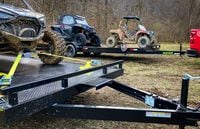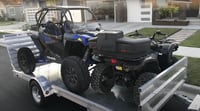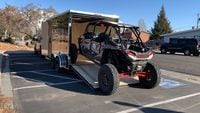The first thing most people think about after buying their first UTV is how they'll transport it. For such a car-like thing, you're not legally allowed to drive it on most public roads. This highlights the need for a quality trailer. But what goes into picking the right one?
You’ll want to start with nothing to do with a trailer or your UTV. Find the maximum tow rating and payload capacity of your tow vehicle. Most modern midsize vehicles are capable of towing a single side-by-side. You’ll want to step up to a half- or three-quarter-ton vehicle if you’re towing multiple machines. The key point here is to remember that the maximum tow rating of your vehicle is just that—an extreme. We recommended staying well below your maximum ratings to keep your trips safe and minimize the strain on your road-going vehicle.
Next let's discuss what kind of trailer might fit your needs. There are three main categories that are typically used to haul UTVs: utility trailers, car-hauler trailers, and enclosed trailers. Utility trailers are the most basic option and can be found at local big-name home improvement stores like Home Depot and Tractor Supply. These are generally open-air, single-axle trailers with rails on three sides to help secure and transport small equipment and materials. Car-hauling trailers are generally more expensive than utility trailers. They are built to be strong enough to transport one or more vehicles. These trailers often have more than one heavy-duty axle, raised flat decks, and ramps to load/unload vehicles. Enclosed trailers are generally the most expensive option because they naturally require more materials to manufacture. They enclose your cargo with four walls, a floor deck, and ceiling. This option is good for locking your expensive possessions out of sight and out of the weather.
The key to picking the right type of trailer is determining how many UTVs you’ll be towing and what you’ll be towing them with. Let’s say you’ve got a midsize Toyota Tacoma rated to tow 6,400 pounds with a payload capacity of 1,000 pounds. You’d like to tow your Honda Talon 1000X that weighs 1,490 pounds, is 7.4 feet long and 5.3 feet wide. You could easily pull your UTV on an affordable utility trailer that’s 10 feet long and 6 feet wide. Now say you’ve got the Toyota Tacoma but you’ve decided to upgrade to a Honda Talon 1000X-4 four-seater UTV that’s 9.7 feet long and 5.3 feet wide. You’d want a longer trailer that’s 12 feet long to give you enough room to safely load your side-by-side securely on the deck of the trailer. My point here is to think ahead at what purchases you might make down the road so you aren’t forced to buy another trailer.
Fact: One of the longest UTVs on the market currently is the Yamaha Viking VI EPS six-seater that measures in at nearly 13.5 feet long.
It’s also common for families or groups of friends to transport multiple UTVs behind one larger truck. In this case you’re probably shopping for a car-hauler or flatbed-type trailer. These will generally come in lengths of 18 feet to more than 30 feet, which will allow you to fit additional equipment on the same trailer. You’re also getting stronger axles, trailer brakes, and a fully boxed frame strong enough to support the weight of additional machines. These trailers are generally heavier than utility trailers depending on how they are built, so keep that in mind when you’re calculating your total weight.
For those traveling more often or over longer distances, the enclosed trailer makes for a good solution. This type acts as both transportation and storage. They are often sold with a slew of add-ons and options to suit each individual's needs. Generally speaking you’re getting a strong trailer deck with three walls, a rear door, and a lightweight roof. Latches let you lock your cargo inside away from prying eyes. This can be good both while traveling and while not in use at home.
Each trailer type can be manufactured using different materials. These materials directly affect the weight of the trailer. This is important because the more total weight you pull, the harder it will be on your towing vehicle. Some trailers will have a steel frame with wooden deck. These are often the heaviest options but also the cheapest versions. Others will opt for a steel frame with steel deck. This results in a very strong trailer that could weigh slightly less. Premium versions will be made entirely of lightweight aluminum. Aluminum trailers are generally the most expensive option, but require less maintenance because you don’t have to worry about things like rot and rust. If you want to keep weight to a minimum, we recommend the aluminum trailer.
Fact: One of the heaviest UTVs on the market currently is the Polaris Ranger XP 1000 NorthStar Edition tipping the scales at just over 2,350 pounds.
There are other things to consider. Plenty of strapping points is a key feature many people overlook. UTVs are tall and should be strapped securely to avoid load shift. Trailer brakes are important if you’re hauling multiple UTVs on longer trailers. And ramp systems can make or break a trailer decision based on what kind of terrain you’re parking on.
No matter what UTV you own there’s a trailer out there that can tow it. Being smart about what you buy can make traveling with your UTV a pleasure or a pain, so be sure to put in the legwork and crunch the numbers to figure out what trailer solution is right for you.













/cloudfront-us-east-1.images.arcpublishing.com/octane/XC6SGFBY6NCRZLAUIZ2UZRCCFM.jpg)
/cloudfront-us-east-1.images.arcpublishing.com/octane/AH7WYYPFMJBYXJWVDX3RNAGBWQ.jpg)
/cloudfront-us-east-1.images.arcpublishing.com/octane/EQREAHBHKBFERICMMOYK3FXOLA.jpg)
/cloudfront-us-east-1.images.arcpublishing.com/octane/UUIJ3D3HOBBETC35LOFZWFHN64.jpg)
/cloudfront-us-east-1.images.arcpublishing.com/octane/ODP76ANA2VBENCL7CRX5WN525A.jpg)
/cloudfront-us-east-1.images.arcpublishing.com/octane/K33FQWFBRNCKRBY33RBYKWSIW4.jpg)
/cloudfront-us-east-1.images.arcpublishing.com/octane/UVWTNXMWWRE4NGTXY756YAR5P4.jpg)
/cloudfront-us-east-1.images.arcpublishing.com/octane/THQALIWY6VENHB72YZVDLTNCY4.jpg)
/cloudfront-us-east-1.images.arcpublishing.com/octane/GI627DHLJFAFDGPV5MKOMLCJMA.jpg)
/cloudfront-us-east-1.images.arcpublishing.com/octane/VG7Q7TT4BZCJDFMVFKYQPGPVO4.jpg)
/cloudfront-us-east-1.images.arcpublishing.com/octane/SE2D6HZFFBC4LP2GM4JRF3PCNE.jpg)
/cloudfront-us-east-1.images.arcpublishing.com/octane/L6J764EOC5G7NMUPXRSMJPTXXI.jpg)
/cloudfront-us-east-1.images.arcpublishing.com/octane/XWO4V5FWQFBEXFJMBLEIOHXUSI.jpg)
/cloudfront-us-east-1.images.arcpublishing.com/octane/KSFN6GF7CFBMJEDMPCJNS76RII.jpg)
/cloudfront-us-east-1.images.arcpublishing.com/octane/OHVTTZYCGZELJL6HCXYWTDLH6E.jpg)
/cloudfront-us-east-1.images.arcpublishing.com/octane/FNS4RFVVUVGHVCICL2OMT5L5AY.jpg)
/cloudfront-us-east-1.images.arcpublishing.com/octane/UMQEEX676VEVBK2L3B4TE7SZEQ.jpg)
/cloudfront-us-east-1.images.arcpublishing.com/octane/NQT2SWT7SJEEZG2RVRLPYCC5CI.jpg)
/cloudfront-us-east-1.images.arcpublishing.com/octane/6BWPJ77CZRH2ZNUNHJXGLK2O6M.jpg)
/cloudfront-us-east-1.images.arcpublishing.com/octane/HHJO75Z6BJCORBNUBGQHRB5B6E.jpg)
/cloudfront-us-east-1.images.arcpublishing.com/octane/EQT2LCW4INBQHNBMDVK6EZGXAU.jpg)
/cloudfront-us-east-1.images.arcpublishing.com/octane/EYOH2KZTYJBCBKYRMYNMG75EHQ.jpg)
/cloudfront-us-east-1.images.arcpublishing.com/octane/WPPTUTZ6SBB7BGD5MIOZZYQNGI.jpg)
/cloudfront-us-east-1.images.arcpublishing.com/octane/N65KBDC3HNHUXFJMJOWWA37IN4.jpg)